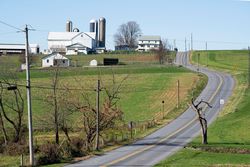Barron's | 22 August 2023
By Abby Schultz
Investing in farmland to buffer inflation
By Abby Schultz
Institutional investors have long had access to agricultural land as an income-generating, consistent hedge against inflation, but for most investors, farmland—unlike other forms of real estate—is out of reach.
Pension funds and other tax-exempt vehicles currently hold about 1,331 U.S. farmland properties valued at US$16.2 billion, according to the National Council of Real Estate Investment Fiduciaries, or NCREIF. Outside of these tax-exempt investments, and a few other privately managed funds and holdings by the ultra-wealthy, retail investors can get exposure to farmland assets through publicly traded real estate investment trusts, such as Farmland Partners Inc. (ticker: FPI) and Gladstone Land LAND +1.43% Corp. (LAND). FPI’s trailing five-year return through Aug. 21 is 12.2%, while Gladstone Land’s is 6.04%, according to Morningstar.
Private investments in farmland, by contrast, have posted average annual returns that have consistently beat inflation since 1991, according to Nuveen Natural Capital, a division of TIAA’s Nuveen. For the year through June 30, the NCREIF Farmland Index posted a cumulative total return of 8.19%. That exceeds consumer price inflation of 3% in the same period, according to the U.S. Bureau of Labor Statistics.
To give a wider swath of investors access to farmland as an asset class, Nuveen Natural Capital is opening its Global Farmland Strategy to qualified retail investors through an evergreen private-market fund sold through iCapital, a fintech platform. The new offering is the same farmland strategy—today holding US$12.4 billion in assets—that’s been held in the TIAA general account and owned by its 5 million plan participants for more than 30 years, says Keith Jones, head of global alternative investment product at Nuveen.
The strategy includes investments in row crops (such as corn, soybean, and rice), vineyards, and horticultural crops (such as almonds and pistachios). Most of its assets are in the U.S., although about 10% is invested in Chile, Jones says.
Penta recently spoke with Jones about Nuveen’s farmland strategy and why Nuveen is opening the doors to a wider group of investors.
Why Farmland?
Agricultural land offers investors a different real estate bet than offices or residential housing. It tends to provide “strong and stable” income, is resilient throughout economic cycles, and investment returns on farmland don’t tend to correlate with public markets, Jones says.
That’s because its performance isn’t typically affected by the broader economic universe. “As we learned in Covid, people don’t necessarily have to go to the office, but people need to eat,” he says.
Another reason the sector tends to be a stable, income-producing inflation hedge is that there is less movement in lease arrangements and property valuations with farmland than with commercial real estate. If an office building with 20 tenants loses a major one, “that can cause issues with valuation right off the bat,” Jones says.
Moreover, the global population is expected to rise to 9 billion people by 2050 at the same time available land for growing food is decreasing. The sector also involves investing in technology and innovations, such as regenerative agricultural practices to advance farming. “What you’re looking into is a solution that the globe needs,” Jones says.
How Is Farmland a Stable Inflation Hedge?
Nuveen’s retail farmland strategy isn’t intended to deliver outsized, double-digit returns to investors. Instead, it will provide a “mid-single-digit type” of income profile on a total-return basis, similar to the NCREIF Farmland Index, Jones says.
The inflation hedge comes from long-term lease arrangements, but also from the fact that crop prices tend to rise along with the costs of goods. That’s “embedded in the way in which we’re operating a lot of these farmland assets,” he says.
In addition to leasing property, Nuveen also owns and operates agricultural land, too, generating cash flow directly from selling crops. The firm also generates some cash from land appreciation, although property sales aren’t common, Jones says.
“It’s one of those asset classes that if it’s not institutionally managed by a Nuveen, then it’s going to be privately owned, so it doesn’t come on the market all that often,” he says.
Nuveen’s strategy of investing across agricultural properties—including row and horticultural crops in addition to vineyards—also adds diversification, which minimizes the inherent risks to agricultural land from wildfires and drought. The target weighting for the portfolio, which is about US$1 billion in size, is about 50% in row crops, and then 50% split evenly between vineyards and horticultural crops.
“That’s kind of the optimal state as we’ve modeled out the return profiles across these three big groups of farmland investments,” Jones says.
‘Playing the Long Game’
Nuveen decided to explore the idea of allowing retail investors into its farmland strategy after hearing from registered investment advisors who serve the high-net-worth investor community, Jones says.
Instead of creating a private-equity structure with limited liquidity and holding periods of as long as 10 years, the firm chose to build a so-called evergreen structure, which are continuously offered private funds.
Though these funds offer more flexibility, they aren’t as liquid as a mutual fund (you can’t buy and sell it in a single day or week), and there are other limitations, he says. “Certainly nobody should be buying this thinking they can try to trade out of it a year later,” Jones says.
Evergreen funds tend to have lower investment minimums and allow for capital to be invested immediately, instead of when a manager asks for cash to close a deal, as is the case with traditional private equity. Investors also can stay invested in these funds for more than a 10-year term, which allows returns to compound.
“We are playing the long game here,” Jones says.














